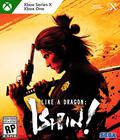The Yakuza series is well-known for action and storytelling. While the mainline games have all been made available on current consoles, the spin-off title Like a Dragon: Ishin! has remained exclusive to Japan until now. This historical period piece has been remade with Unreal Engine 4 (and some all-new content) and is ready for an English release. We recently got a chance to spend some time with Chapter 3 of the game, which allowed for a peek at the story as well as some open-world minigames.
Like a Dragon: Ishin! is meant to stay true to the Japanese original, but it isn't a straight port. The remaster changes up a few things, including the use of current Yakuza character models and voice actors. To be clear, these are not the same characters, nor are they meant to be ancestors of the Yakuza characters. Instead, in a somewhat meta move, the Yakuza characters are actors playing historical characters in the game. Think of it as a movie with your favorite characters as stars.
Anyone used to playing one of the Yakuza games is going to feel at home with the interface. The architecture and time period are very different, but navigation, movement, and combat work as expected.
Those who like variety will appreciate the four combat options, as you have the ability to switch between swordsman, gunman, wild dancer (gun and katana), and brawler. Swapping between the styles can be done at will, even during a fight. During the end of my time with the demo, I was whittling down the boss's health bar, but mine was also dropping. In a minor state of panic, I decided that winning was better than looking cool, so instead of rushing in for the kill with my katana, I went with my gun. It may not have been noble, but I got the win.
Before getting to the boss fight, I spent time exploring the story. You're framed for the death of your father and traveling under an assumed name, and your goal is to discover his true killer. Your only clue is the style used to execute your father, the Tennen Rishin. Someone in the Shinsengumi is known to use that style, so the goal becomes one of infiltration.
After exploring the local town, I found the Shinsengumi temple and opted into tryouts. This was the first "real" fight I experienced, as it required parrying and dodging to win. It was a noticeable step up from the thugs you run across on the street, but at the same time, it didn't feel unfair. If anything, I would say it's deliberate. It almost felt as though the fight was designed as a training battle to force me to use different techniques and not just power through. At the same time, the game isn't designed to frustrate players. If you lose a few rounds, Like a Dragon: Ishin! offers to temporarily drop the difficulty.
After winning, I was inducted into the Shinsengumi, given my own room, and had time to explore the local town, Gion. I can't say for certain, as I never played the original, but I'm guessing my time as a Shinsengumi will last through most of the story. After all, they did give me a room that serves as a place to rest and store items.
Since the aforementioned boss fight was the next thing in the story (and the last part of the demo), I wandered around to check out some of the minigames. Because this is ancient Japan, there are no Sega retro arcade games hidden within. What I did find was a gambling den, dance classes, and a brothel with a drinking game and strip rock-paper-scissors.
The gambling den had five different games that use both cards and dice. You need to gamble with in-game money, but aside from that, you're free to have fun. Just don't let your money run out. The dancing game is a basic rhythm game with four directions. Over at the brothel, the drinking game was rather simple (keep the drinking bowl balanced by tapping buttons), but my AI opponent was ruthless when it came to strip rock-paper-scissors. My dude was down to his in-game skivvies in no time.
Other minigames that I didn't have a chance to find include singing, working at the udon shop, cannon coaching, scarecrow chateau, fishing, wood chopping, chicken racing, shogi, and mahjong.
In addition to the minigames, Like a Dragon: Ishin! has optional side-quests (called substories) that are given by the local townspeople. They can be straightforward or crazy, but they can be the key to unlocking new locations and activities. You can also get information and items by completing substories.
Whether you're a longtime Yakuza fan or new to the franchise, Like a Dragon: Ishin! should be an accessible experience. Franchise fans will note some of the references, but as a standalone story, there is no reliance on the other games. If you're feeling lost, the in-game Bakumatsu Archives has supplementary story and character information.
Finally, there is the relationship system. I didn't really get a chance to explore this in-depth, as I just met a few people in the game and formed basic bonds with them. How this develops is something that we'll have to find out once Like a Dragon: Ishin! drops next month.
More articles about Like A Dragon: Ishin!











 In 1860s Kyo, a solemn samurai's fight for justice stands to change the course of Japan's history forever. Draw your blade and join the revolution in this heated historical adventure.
In 1860s Kyo, a solemn samurai's fight for justice stands to change the course of Japan's history forever. Draw your blade and join the revolution in this heated historical adventure.







































